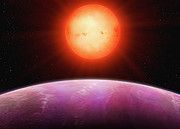Announcement
New Exoplanet Survey Finds its First Planet
31 October 2017
The Next Generation Transit Survey (NGTS) instrument at ESO’s Paranal Observatory in northern Chile has found its first exoplanet, a hot Jupiter orbiting an M-dwarf star [1] now named NGTS-1. The planet, NGTS-1b, is only the third gas giant to have been observed transiting an M-dwarf star, following Kepler-45b and HATS-6b. NGTS-1b is the largest and most massive of these three, with a radius of 130% and a mass of 80% those of Jupiter.
The NGTS uses an array of twelve 20-centimetre telescopes to search for the tiny dips in the brightness of a star caused when a planet in orbit around it passes in front of it (“transits”) and blocks some of its light. Once NGTS-1b had been discovered its existence was confirmed by follow-up observations at ESO’s La Silla Observatory: photometric observations with EulerCam on the 1.2-metre Swiss Leonhard Euler Telescope; and spectroscopic investigations with the HARPS instrument on ESO’s 3.6-metre telescope.
Small planets are relatively common around M-dwarf stars, whereas gas giants like NGTS-1b appear to be rarer around M-dwarfs than they are around stars more like the Sun. This is consistent with current theories of planet formation, but observations of more M-dwarfs are needed before a clear understanding of the numbers of giant planets around them can be arrived at. The NGTS is specifically designed to provide better data on planets around M-dwarf stars, and since they account for around 75% of stars in the Milky Way, studying them will help astronomers to understand the majority population of planets in the Galaxy.
The future could be very exciting for this exoplanet system as it has the potential to be studied in greater detail by the suite of instruments on board the NASA/ESA/CSA James Webb Space Telescope (JWST) which is due to be launched in 2019.
Notes
[1] An M-dwarf is a small, faint star with approximately 8–50% of the mass of the Sun and with a surface temperature of less than 3700°C. 50 of the closest 60 stars to our Solar System are thought to be M-dwarfs, even though not a single one is bright enough to be visible from the Earth with the naked eye.
More Information
This research is presented in a paper entitled “NGTS-1b: A hot Jupiter transiting an M-dwarf”, by D. Bayliss et al., to appear in the journal Monthly Notices of the Royal Astronomical Society.
The team is composed of: D. Bayliss (Université de Genève, Switzerland), E. Gillen (University of Cambridge, United Kingdom), P. Eigmüller (DLR, Germany), J. McCormac (University of Warwick, United Kingdom), R. Alexander (University of Leicester, United Kingdom), D. Armstrong (University of Warwick, United Kingdom), R. Booth (Queen's University Belfast, United Kingdom), F. Bouchy (Université de Genève, Switzerland), M. Burleigh, J. Cabrera (DLR, Germany), S. Casewell, A. Chaushev (University of Leicester, United Kingdom), B. Chazelas, S. Csizmadia, A. Erikson, F. Faedi (University of Warwick, United Kingdom), E. Foxwell (University of Warwick, United Kingdom), B. Gaensicke (University of Warwick, United Kingdom), M. Goad (University of Leicester, United Kingdom), A. Grange, M. Guenther (University of Cambridge, United Kingdom), S. Hodgkin (University of Cambridge, United Kingdom), J. Jackman, J. Jenkins (Universidad de Chile, Chile), G. Lambert (University of Cambridge), T. Louden (University of Warwick, United Kingdom), L. Metrailler (Université de Genève, Switzerland), M. Moyano (Universidad Católica del Norte, Chile), D. Pollacco (University of Warwick, United Kingdom), K. Poppenhaeger, (Queen's University Belfast, United Kingdom; Harvard-Smithsonian Center for Astrophysics, United States), D. Queloz (Université de Genève, Switzerland), R. Raddi (University of Warwick, United Kingdom), H. Rauer (DLR, Germany), L. Raynard (University of Leicester, United Kingdom), A. Smith, M. Soto (Universidad de Chile, Chile), A. Thompson (Queen’s University Belfast, United Kingdom), R. Titz-Weider (DLR, Germany), S. Udry (Université de Genève, Switzerland), S. Walker (University of Warwick, United Kingdom), C. Watson (Queen's University Belfast, United Kingdom), R. West (University of Warwick, United Kingdom) and P.J. Wheatley (University of Warwick, United Kingdom).
Links
- Science paper 1: The Next Generation Transit Survey (NGTS)
- Science paper 2: NGTS-1b: A hot Jupiter transiting an M-dwarf
Contacts
Daniel Bayliss
Department of Physics
University of Warwick
, UK
Tel: +44 (0) 24761 50342
Cell: +44 (0) 7514912757
Email: d.bayliss@warwick.ac.uk
Richard Hook
ESO Public Information Officer
Garching bei München, Germany
Tel: +49 89 3200 6655
Cell: +49 151 1537 3591
Email: rhook@eso.org
About the Announcement
| Id: | ann17076 |


